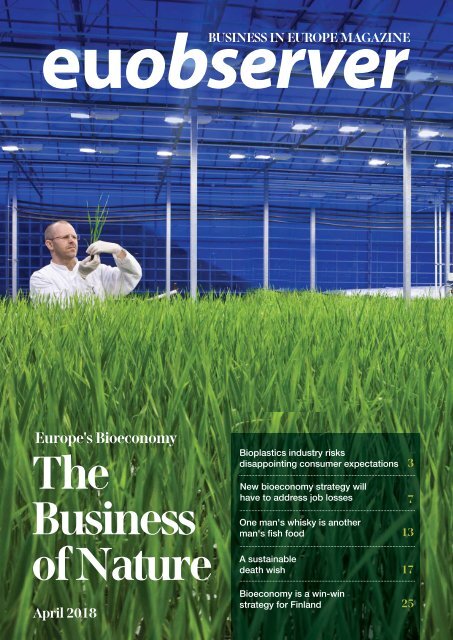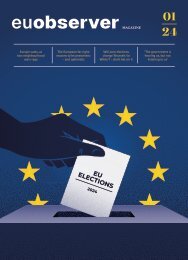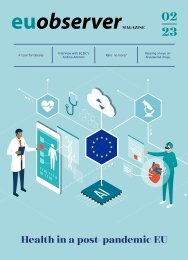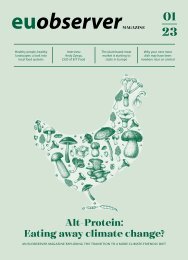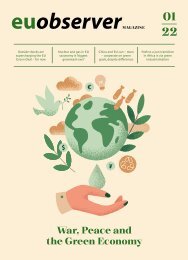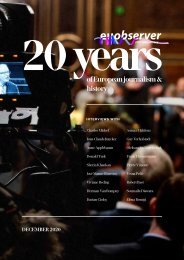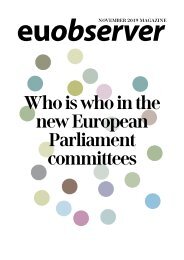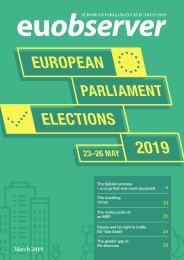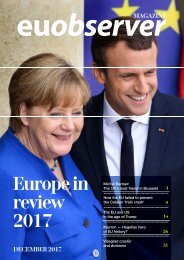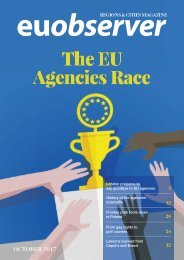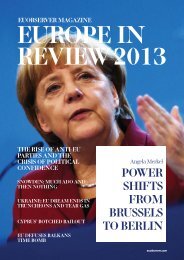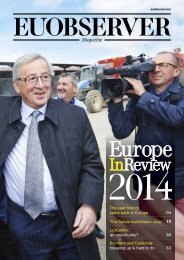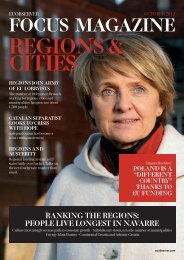Europe's Bioeconomy: The Business of Nature
EUobserver's 2018 Business in Europe magazine takes a closer look at Europe's bioeconomy and how "the business of nature" is changing the way people look at waste and natural resources.
EUobserver's 2018 Business in Europe magazine takes a closer look at Europe's bioeconomy and how "the business of nature" is changing the way people look at waste and natural resources.
You also want an ePaper? Increase the reach of your titles
YUMPU automatically turns print PDFs into web optimized ePapers that Google loves.
BUSINESS IN EUROPE MAGAZINE<br />
<strong>Europe's</strong> <strong>Bioeconomy</strong><br />
<strong>The</strong><br />
<strong>Business</strong><br />
<strong>of</strong> <strong>Nature</strong><br />
April 2018<br />
Bioplastics industry risks<br />
disappointing consumer expectations 3<br />
New bioeconomy strategy will<br />
have to address job losses<br />
One man's whisky is another<br />
<br />
A sustainable<br />
death wish 17<br />
7<br />
13<br />
<strong>Bioeconomy</strong> is a win-win<br />
25
euobserver<br />
EDITORIAL ADDRESS<br />
EUobserver Magazine<br />
Rue Montoyer 18B<br />
1000 Brussels<br />
Belgium<br />
contact@euobserver.com<br />
Editor<br />
<br />
<br />
<br />
ARTICLE LAYOUT<br />
Art director:<br />
Tobias Andreasen<br />
ADVERTISING<br />
EUobserver Magazine<br />
Rue Montoyer 18B<br />
1000 Brussels<br />
Belgium<br />
advertising@euobserver.com<br />
DISTRIBUTION<br />
EUobserver Magazine<br />
Rue Montoyer 18B<br />
1000 Brussels<br />
Belgium<br />
<br />
mc@euobserver.com<br />
PUBLISHER<br />
EUobserver.com ASBL<br />
<br />
<br />
<br />
<br />
<br />
<br />
account.<br />
HIGH QUALITY JOURNALISM<br />
<br />
<br />
<br />
<br />
<br />
<br />
<br />
<br />
<br />
<br />
<strong>The</strong> <strong>Business</strong> <strong>of</strong><br />
<strong>Nature</strong><br />
If you are like the average EU citizen, you probably haven't<br />
heard <strong>of</strong> the bioeconomy.<br />
<strong>The</strong> European Commission itself admits: "<strong>The</strong> bioeconomy is<br />
not a well-known concept among European citizens, due to<br />
lack <strong>of</strong> information - or information that cannot be understood<br />
by the general public."<br />
<strong>The</strong> commission has now decided that EU citizens need to<br />
know more about the bioeconomy. To do that, it is willing<br />
to spend up to €2 million on a project that should bring<br />
bioeconomy research and innovation closer to the public.<br />
<strong>The</strong> project, called Bloom, will establish five regional hubs to<br />
"create a space <strong>of</strong> knowledge exchange and debate".<br />
Eurosceptics may dismiss it as a waste <strong>of</strong> taxpayers' money<br />
on propagating a buzzword, but others may applaud the<br />
effort to increase awareness <strong>of</strong> new environmental scientific<br />
ventures.<br />
For the record, this is how the European Commission<br />
describes the bioeconomy: "<strong>The</strong> bioeconomy comprises those<br />
parts <strong>of</strong> the economy that use renewable biological resources<br />
from land and sea – such as crops, forests, fish, animals and<br />
micro-organisms – to produce food, materials and energy."<br />
And so whilst 'bioeconomy' itself may be a buzzword, the<br />
activities that comprise it are very real. Later this year, the<br />
commission will present a review <strong>of</strong> its bioeconomy strategy,<br />
so this third edition <strong>of</strong> EUobserver's <strong>Business</strong> in Europe<br />
magazine is very timely.<br />
We take you along a tour <strong>of</strong> various sectors <strong>of</strong> the bioeconomy,<br />
including <strong>Europe's</strong> pig farmers and Finland's forest-based<br />
industries. You will also learn about the carbon footprint <strong>of</strong><br />
death and whiskey-based fish food.<br />
Happy reading!<br />
Peter Teffer<br />
While we did not need €2 million to create this<br />
magazine, independent and investigative journalism<br />
does require funding. Please consider subscribing to<br />
EUobserver. Go to our website and sign up.
Bioplastics industry<br />
risks disappointing<br />
consumer expectations<br />
Photo: Kate Ter Haar<br />
Europe is trying to kick its addiction to plastic, so businesses are on<br />
the hunt for alternatives. Bioplastics could replace 60 percent <strong>of</strong> plastic<br />
packaging on the market, but the switch is far from straightforward.<br />
By David Burrows<br />
In 2016, new research was presented at<br />
the 11th European Bioplastics Conference<br />
in Berlin. Around 1,700 German citizens<br />
were asked whether they had heard <strong>of</strong> the<br />
term 'bioplastics' before: 43 percent had and the<br />
rest hadn't. However, <strong>of</strong> the ones who did know<br />
the term, 84 percent <strong>of</strong> them didn't really have a<br />
clue what it meant.<br />
"In the many years that I've spent writing about<br />
the niche in the plastics industry known as<br />
bioplastics, I've never ceased to be amazed<br />
[by] the pr<strong>of</strong>ound ignorance that abounds about<br />
bioplastics," said Karen Laird, editor at Plastic<br />
News Europe.<br />
<strong>The</strong> term bioplastics certainly doesn't help.<br />
'Bio' conjures up feelings <strong>of</strong> 'natural' or<br />
'environmentally friendly' whereas the rising tide<br />
<strong>of</strong> plastic waste has become a "planetary crisis".<br />
Research by Julia-Maria Blesin at the Hochschule<br />
Hannover has shown that when people hear the<br />
phrase bioplastics they tend to jump to certain<br />
conclusions: that it's completely plant-based, for<br />
instance, or that the raw materials are organically<br />
cultivated.<br />
She believes that most consumers have<br />
"unrealistically high expectations in the<br />
sustainability <strong>of</strong> bioplastics".<br />
For some companies, this ignorance is bliss<br />
because they can get away with greenwash.<br />
Oxobiodegradable plastics are a case in<br />
point. Though sold on the basis that they will<br />
help to "protect the environment" because<br />
they biodegrade, the European Commission<br />
03 — BUSINESS IN EUROPE MAGAZINE 2018
thinks otherwise: "[<strong>The</strong>y] have been found<br />
to <strong>of</strong>fer no proven environmental advantage<br />
over conventional plastics, while their rapid<br />
fragmentation into microplastics cause concerns."<br />
Work is now underway to restrict their use in the<br />
EU. But the problems don't end there.<br />
SOMETIMES MORE HARMFUL<br />
THAN PLASTIC<br />
Designers and brands are just as confused as<br />
their customers.<br />
An investigation in the UK recently by<br />
FoodserviceFootprint.com found that the<br />
country's largest pub chains have been left<br />
bamboozled after switching from plastic to<br />
compostable straws. In some cases, the straws<br />
made from polylactic acid (PLA) – a plastic<br />
substitute derived from plants that will biodegrade<br />
within three months in a controlled composting<br />
environment – were ending up in landfills where<br />
they are actually more harmful than plastic.<br />
Even the association representing the bioplastics<br />
sector admits that explaining its wares is tricky:<br />
"It's hard to communicate all pros and cons <strong>of</strong> the<br />
very different bioplastics in an appropriate way,"<br />
suggests Hasso von Pogrell, managing director<br />
<strong>of</strong> European Bioplastics.<br />
A clear definition would certainly help.<br />
To date, the term bioplastics is loosely used to<br />
refer to plastics that are biobased, biodegradable,<br />
or both. Biobased means they are made at least<br />
in part from renewable materials derived from<br />
plants (like corn or cellulose) instead <strong>of</strong> fossil<br />
resources, according to the European Bioplastics<br />
website.<br />
Some can also be biodegradable in industrial<br />
composting facilities (there is a European<br />
<br />
<br />
Photo: European Commission<br />
Article continues on page 6<br />
04 — BUSINESS IN EUROPE MAGAZINE 2018
Ready for<br />
your new<br />
adventure<br />
in Belgium?<br />
ING makes your life easy<br />
by helping you organize<br />
all your financial affairs.<br />
Call +32 2 464 66 64,<br />
or go to ing.be/expats<br />
Banking, financial and/or insurance <strong>of</strong>fer subject to acceptance by ING Belgium (or, where appropriate, the relevant insurance company) and to mutual agreement. Terms and conditions (regulations, rates, key<br />
information documents for investors or savers and other supplementary information) available from any ING branch or on www.ing.be. ING Belgium 05 — SA/nv BUSINESS – Bank – Avenue IN EUROPE Marnix 24, MAGAZINE B-1000 Brussels 2018 – Brussels RPM/RPR<br />
– VAT: BE 0403.200.393 – BIC: BBRUBEBB – IBAN: BE45 3109 1560 2789. Insurance broker registered with the FSMA under the number 12381A. Publisher: Marie-Noëlle De Greef – Cours Saint-Michel 60, B-1040 Brussels.
standard, EN13432, for products that meet certain<br />
criteria for compostability), and can therefore be<br />
collected alongside food waste, for example.<br />
without adequate waste collection and treatment,<br />
it could aggravate plastics leakage and create<br />
problems for mechanical recycling".<br />
But as von Pogrell explained at an event in<br />
Brussels organised by the European Policy<br />
Centre in February: "Biobased plastics are not<br />
necessarily biodegradable and compostable<br />
plastics are not necessarily biobased."<br />
Some bioplastics can therefore be recycled with<br />
their plastic cousins (though they can lose some<br />
physical properties after several 'cycles'), but<br />
some can't and therefore end up contaminating<br />
collections.<br />
How do you decipher which is which? With great<br />
difficulty.<br />
EU RULES ON COMPOSTABLE<br />
PLASTICS<br />
Brussels decided to step in. Proposed amendments<br />
to the packaging and packaging waste directive as<br />
well as the new plastics strategy published by the<br />
European Commission in January recognised the<br />
role bioplastics could play in helping "decrease<br />
our dependency on fossil fuels." Plastics' share <strong>of</strong><br />
global oil consumption is expected to rise from six<br />
percent in 2014 to 20 percent by 2050, according<br />
to the Ellen MacArthur Foundation.<br />
However, the commission said, "in the absence<br />
<strong>of</strong> clear labelling or marking for consumers, and<br />
To avoid "false environmental claims" and<br />
reduce confusion, the commission will publish<br />
harmonised rules for labelling "compostable" or<br />
"biodegradable" plastics. A life cycle assessment<br />
will also be developed to ensure biobased<br />
plastics result in "genuine environmental benefits<br />
compared to the non-renewable alternatives".<br />
<strong>The</strong> commission can't afford to hang about,<br />
either. As well its own anti-plastic legislative<br />
push, there's a pull from consumers looking for<br />
alternatives – the likes <strong>of</strong> Coca-Cola, Danone<br />
and Puma are all showing heightened interest<br />
in bioplastics - and Europe is where the action<br />
will be. <strong>Europe's</strong> share <strong>of</strong> global bioplastics<br />
production is forecast to jump from 18 percent<br />
to 25 percent between now and 2022; packaging<br />
will also remain the strongest segment.<br />
This could create jobs, reduce carbon emissions,<br />
make use <strong>of</strong> waste and revive rural areas,<br />
according to the bioplastics industry.<br />
But we shouldn't get too carried away. "If anyone<br />
thinks bioplastics will save the planet they are<br />
delusional," says one industry leader. Indeed, the<br />
most pressing issue is to reduce excessive and<br />
unnecessary use <strong>of</strong> plastics.<br />
<br />
Photo: Arshad Pooloo<br />
06 — BUSINESS IN EUROPE MAGAZINE 2018
NEW BIOECONOMY<br />
STRATEGY WILL HAVE<br />
TO ADDRESS JOB<br />
LOSSES<br />
<strong>The</strong> European Commission's 2012 bioeconomy strategy is in need <strong>of</strong><br />
an update, with even the commission itself admitting the paper had<br />
weaknesses.<br />
<br />
Bulgaria had apparently not received word<br />
<strong>of</strong> the bad news. Neither had the European<br />
commissioner for agriculture, Phil Hogan.<br />
dropped consistently. By 2014, the most recent<br />
<br />
stood at 18.59 million.<br />
Last February, Bulgaria opened a debate at a<br />
meeting <strong>of</strong> agriculture ministers with a paper stating<br />
that the bioeconomy employed around 22 million<br />
<br />
While the overall job market in the EU shrunk<br />
during that period, the bioeconomy sector was hit<br />
proportionally harder. A large share <strong>of</strong> that is due to<br />
a relentless drop in agriculture jobs.<br />
<strong>The</strong> bad news was that their information was<br />
<br />
bioeconomy strategy paper, published back in<br />
February 2012.<br />
At the presentation <strong>of</strong> the strategy in Brussels, Maire<br />
Geoghegan-Quinn, who was the EU commissioner<br />
for research, innovation and science, at the time,<br />
said the bioeconomy was not simply a "niche area",<br />
it also promoted growth and jobs.<br />
Between 2008 and 2014 over a million farm jobs<br />
evaporated. <strong>The</strong> wood production and wooden<br />
furniture sector also saw some 380,000 jobs lost.<br />
STRATEGY HAD 'WEAKNESSES'<br />
<br />
outdated in the 2012 bioeconomy strategy paper<br />
and accompanying action plan. <strong>The</strong> commission has<br />
planned to overhaul the entire strategy.<br />
"With an annual turnover <strong>of</strong> around two trillion<br />
euro, and employing around 22 million people, the<br />
bioeconomy is already one <strong>of</strong> the Union's biggest<br />
and most important sectors. Its potential for the<br />
future is even greater," she said.<br />
More recent estimates showed that the sector<br />
<br />
the commission's in-house think tank, the Joint<br />
Research Centre, revealed the total number <strong>of</strong><br />
bioeconomy jobs in the EU was never that high.<br />
Instead, it has been decreasing steadily.<br />
In 2008, the bioeconomy employed 20.76 million<br />
<br />
In November 2017, the commission published a review<br />
<strong>of</strong> its own strategy paper. Although it was worded<br />
diplomatically, it was nothing short <strong>of</strong> a scathing<br />
<br />
<br />
natural resources sustainably; reduce dependence on<br />
fossil fuels; mitigate and adapt to climate change; and<br />
job creation.<br />
<strong>The</strong> review said that the "intrinsic weaknesses" <strong>of</strong><br />
the strategy and action plan was that goals were<br />
only generally described, and that the goals lacked<br />
<br />
targets.<br />
07 — BUSINESS IN EUROPE MAGAZINE 2018
Photo: European Commission<br />
<br />
progress and fully assess, or evaluate, the extent to<br />
which the implementation <strong>of</strong> the actions contribute to<br />
<br />
"Also, the sheer number and diversity <strong>of</strong> (sub-)<br />
actions may have resulted in a sub-optimal focus<br />
and some overlap," it added.<br />
A WESTERN EUROPEAN AFFAIR<br />
Another critique was that the goals <strong>of</strong> the bioeconomy<br />
strategy were also the goals <strong>of</strong> many other EU<br />
policies.<br />
"<strong>The</strong>se policies and other factors such as the macro-<br />
<br />
on addressing these objectives. It is, therefore,<br />
not possible in this review to quantify the direct<br />
contributions that the bioeconomy strategy and<br />
its action plan have made to help achieve these<br />
objectives."<br />
<strong>The</strong> review did say that the strategy has helped<br />
increase awareness <strong>of</strong> the importance <strong>of</strong> the<br />
bioeconomy, but some caveats can be added there<br />
too.<br />
<strong>The</strong> 2012 paper had called on EU member states<br />
to come forward with their own national bioeconomy<br />
strategies. <strong>The</strong> review found that those countries<br />
<br />
states that have been EU members since before<br />
2004, while central and eastern EU countries "lag<br />
behind".<br />
An east-west division can also be distinguished<br />
<br />
bioeconomy sector. In 2014, 88 percent <strong>of</strong> the €2.2<br />
trillion in turnover was made in the EU15. In part,<br />
that is because in eastern EU states the bioeconomy<br />
sector is mostly made up <strong>of</strong> agriculture jobs.<br />
<strong>The</strong> agriculture and forestry sectors are still too<br />
<strong>of</strong>ten nothing more but a supplier <strong>of</strong> raw material,<br />
EU agriculture commissioner Hogan said at the<br />
February ministerial meeting.<br />
"<strong>The</strong> bioeconomy has the potential to improve the<br />
living conditions <strong>of</strong> primary producers – our farmers<br />
and foresters - by creating additional outlets for<br />
higher value-added products as well as spurring<br />
innovation in the primary sector. However, in order<br />
to achieve this potential, primary producers need to<br />
play a more active role in the value creation <strong>of</strong> the<br />
bioeconomy supply chains," he said.<br />
<strong>The</strong> commission has scheduled publication <strong>of</strong> the<br />
reviewed bioeconomy strategy for the third quarter<br />
<strong>of</strong> 2018.<br />
08 — BUSINESS IN EUROPE MAGAZINE 2018
<strong>The</strong> EU's bioeconomy in figures<br />
<strong>The</strong> following pages provide an overview <strong>of</strong> the development <strong>of</strong> jobs and annual<br />
turnover in ten subsectors <strong>of</strong> the bioeconomy, as defined by the European<br />
Commission's in-house think tank, the Joint Research Centre. More traditional<br />
sectors like agriculture and wood production have seen a reduction in jobs,<br />
which was not fully <strong>of</strong>fset by new jobs in newer fields like bio-based chemicals.<br />
Annual turnover figures are in millions <strong>of</strong> euros.<br />
Source: Joint Research Centre<br />
Infographic: Tobias Andreasen<br />
09 — BUSINESS IN EUROPE MAGAZINE 2018
10 — BUSINESS IN EUROPE MAGAZINE 2018
Jobs in the bioeconomy in 2014<br />
<strong>The</strong> European bioeconomy still employs most people in traditional sectors like<br />
agriculture. <strong>The</strong> more recent fields like bio-based chemicals, bi<strong>of</strong>uels and biobased<br />
electricity account for only a small slice <strong>of</strong> total employment.<br />
Forestry<br />
Bio-based chemicals, pharmaceuticals<br />
and plastics (excl. bi<strong>of</strong>uels)<br />
Manufacture <strong>of</strong> paper and<br />
paper products<br />
Fishery<br />
Bi<strong>of</strong>uels<br />
Bio-based electricity<br />
Bio-based textiles<br />
Wood products and<br />
furniture<br />
Food, beverage and<br />
tobacco industry<br />
Agriculture<br />
11 — BUSINESS IN EUROPE MAGAZINE 2018
STAKEHOLDER<br />
BIO-BASED INDUSTRIES JOINT UNDERTAKING (BBI JU):<br />
Helping Europe deliver<br />
sustainable everyday products for<br />
European citizens<br />
<strong>The</strong> Bio-based Industries<br />
Joint Undertaking (BBI<br />
JU) is a public-private<br />
partnership between the<br />
European Union (EU) and the Biobased<br />
Industries Consortium (BIC)<br />
with a €3.7 billion budget, established<br />
to fund projects that will address<br />
the need for sustainable industries<br />
and everyday consumer products in<br />
Europe. BBI JU is leveraging private<br />
investment from many industrial<br />
sectors using public funding from<br />
Horizon 2020. <strong>The</strong> programme has<br />
a key role in de-risking investments<br />
from the private sector to encourage<br />
research and innovation. This will<br />
help structure the bio-based sector<br />
for critical mass, essential for market<br />
<br />
BBI JU projects <strong>of</strong>fer innovative<br />
solutions for renewable raw materials<br />
and waste. Clothes made <strong>of</strong> milk<br />
that would otherwise be wasted,<br />
dishwasher-safe, re-useable c<strong>of</strong>fee<br />
cups made from c<strong>of</strong>fee waste, bicycles<br />
<br />
vehicle tyres made from dandelion<br />
rubber are just some <strong>of</strong> the examples<br />
showing the potential <strong>of</strong> bio-based<br />
industries in Europe. <strong>The</strong> development<br />
<strong>of</strong> these kind <strong>of</strong> products can pave<br />
the way for the creation <strong>of</strong> new jobs<br />
particularly in rural areas and<br />
substantially contribute to their<br />
development.<br />
<br />
strong European bio-based industrial<br />
<br />
<br />
raw materials and products. This will<br />
help the EU to meet its climate change<br />
targets and lead to more sustainable<br />
and more environmental friendly<br />
socio-economic growth. Learning to<br />
use and re-use precious resources in<br />
a sustainable way is essential for our<br />
secure economic future.<br />
<br />
the potential <strong>of</strong> new types <strong>of</strong> biomass.<br />
Innovative value chains within the<br />
bio-based sector can provide new<br />
outlets for agricultural products and<br />
by-products. In this way, sources<br />
<strong>of</strong> income for farmers and rural<br />
population can be increased and<br />
<br />
with the vision <strong>of</strong> thriving and resilient<br />
rural communities in Europe. At the<br />
same time, the development <strong>of</strong> a<br />
bio-based sector has the potential<br />
to create much-needed jobs in<br />
rural areas, and to contribute to<br />
more circular, climate-friendly and<br />
<br />
forestry practices.<br />
Access to new and improved biobased<br />
everyday products that are<br />
comparable or superior to fossilbased<br />
ones mean better consumer<br />
choices for our citizens. As consumers<br />
start to become environmentally<br />
ly<br />
more aware, the demand for products<br />
from sustainable manufacturing<br />
processes, including bio-based<br />
products is also increasing. High<br />
performing advanced bio-based<br />
materials <strong>of</strong>fer a broad range<br />
<strong>of</strong> properties and a combined<br />
outstanding performance and<br />
resistance. BBI JU is working to prove<br />
this can be done at commercially<br />
viable sustainable levels using<br />
home-grown European biomass.<br />
BBI JU projects are developing and<br />
testing new sustainable production<br />
processes and European industries<br />
are at the forefront <strong>of</strong> these advances<br />
<strong>The</strong> bio-based economy is already<br />
<br />
but there is still a massive potential<br />
<br />
programme is paving the way to a<br />
<br />
and competitive society, boosting<br />
<br />
our future and bringing re bio-based<br />
products to our lives.<br />
Follow BBI JU on Twitter @BBI2020<br />
Or visit our website www.bbi-europe.eu
One man's whisky is<br />
another man's fish food<br />
<br />
As Scotland's whisky producers look for an alternative to feed their salmon<br />
with, one company <strong>of</strong>fers omega-3 rich algae to do the trick.<br />
<br />
T <br />
was littered with petri dishes, conical<br />
<br />
He was experimenting with ways<br />
to encourage algae to grow on various types <strong>of</strong><br />
waste. Progress was slow.<br />
For one, it was harder to get hold <strong>of</strong> the waste than<br />
one might think (very few companies are happy<br />
to "pull their shorts down" for their waste to be<br />
examined, according to Martin). <strong>The</strong> set-up was<br />
also pretty basic.<br />
Still, he managed to use industrial wastewater to<br />
grow omega-3 rich microalgae, which could be<br />
<br />
what you can do without your landlord knowing,"<br />
he says.<br />
Today, Martin sits proudly in the microbial cell<br />
laboratory at Heriot-Watt University in Edinburgh,<br />
Scotland, surrounded by state-<strong>of</strong>-the-art incubators<br />
and fermenters worth tens <strong>of</strong> thousands <strong>of</strong> euros.<br />
He is on the cusp <strong>of</strong> securing the investment he<br />
needs (£0.5m, €0.56m) to start pilot-scale trials<br />
with Diageo, the world's largest producer <strong>of</strong> spirits,<br />
as well as increasing staff at MiAlgae, the company<br />
<br />
<strong>The</strong> plan is to take by-products from the whiskymaking<br />
process, called pot ale, add particular<br />
strains <strong>of</strong> microalgae, other secret ingredients, and<br />
allow the algae to bloom inside a specially designed<br />
50-litre fermenter. Could these microalgae <strong>of</strong> his<br />
actually turn out to be big business?<br />
"This isn't a science project," he tells me on a visit<br />
13 — BUSINESS IN EUROPE MAGAZINE 2018
to the laboratory, part <strong>of</strong> IBioIC's FlexBio Centre<br />
at the university, earlier this month. "You can have<br />
the greenest technology in the world but it's no<br />
good if there's no money to be made [from it]."<br />
THE BUSINESS SIDE OF WASTE<br />
Martin may be trained as a geneticist and<br />
microbiologist but it quickly becomes clear that he<br />
is a businessman too. Everything the team does<br />
must be potentially scalable, which is not surprising<br />
given the waste at their disposal.<br />
For every litre <strong>of</strong> whisky produced there are eight<br />
litres <strong>of</strong> pot ale (a statistic the whisky producers<br />
do not like to publicise). <strong>The</strong> majority <strong>of</strong> this 'coproduct',<br />
as distillers call it, is spread on land,<br />
discharged at sea or treated as wastewater. Some<br />
are used for livestock feed but the energy demands<br />
are high and the returns are low.<br />
Martin believes his approach is more commercially<br />
viable. <strong>The</strong> fermenters aren't cheap to build (the<br />
<br />
is because they're testing strains that grow well<br />
without light because a glass fermenter would be<br />
much pricier) or run, especially as he expands to<br />
1,000 litre and eventually 30,000 litre capacities.<br />
Having them on site at distilleries will cut transport<br />
costs and, as scale increases, costs will fall. He will<br />
also be selling into a market that is set to expand<br />
rapidly and supply customers that are hungry for<br />
<br />
FISH FEED PROBLEM<br />
<strong>The</strong> aquaculture sector in Scotland supports<br />
around 8,000 jobs and is worth £1.8bn to the<br />
<br />
Scotland's top food export: £600m in 2017, the<br />
highest ever and an increase <strong>of</strong> 35 percent against<br />
2016. By 2030 the plan is to double the size <strong>of</strong> the<br />
country's aquaculture (there are similar projections<br />
for <strong>Europe's</strong> sector) and that means demand for<br />
feed will rocket too.<br />
But there is a problem. Historically, the two most<br />
<br />
<br />
<br />
<br />
Photo: IBioIC<br />
14 — BUSINESS IN EUROPE MAGAZINE 2018
Photo: IBioIC<br />
<br />
<br />
exploited or depleted there is a heavy price to pay<br />
<br />
headaches too, including sea lice, which are hitting<br />
production and threatening the industry's 'clean'<br />
image).<br />
Fish oil prices are also extremely volatile, hitting<br />
a peak <strong>of</strong> $2,500 per tonne a couple <strong>of</strong> years<br />
ago and forcing many feed manufacturers to look<br />
even harder for alternatives. Grains and oilseeds,<br />
<br />
increasingly added to mixtures in the past couple<br />
<strong>of</strong> decades.<br />
<br />
percent <strong>of</strong> salmon feed in 1990 and vegetal raw<br />
<br />
to nine percent whilst the plant-based portion had<br />
15 — BUSINESS IN EUROPE MAGAZINE 2018
ocketed to 74 percent. This swing has created a<br />
<br />
article in April 2017.<br />
OMEGA-3<br />
<br />
long-chain polyunsaturated fatty acids are an<br />
<br />
<br />
feed led to farmed Atlantic salmon with high levels<br />
<strong>of</strong> omega-3, which went down well with healthconscious<br />
consumers.<br />
now taking just a week to deliver a result. <strong>The</strong> tests<br />
are small, but produce vast amounts <strong>of</strong> data so<br />
they can identify which strains grow well and under<br />
what conditions.<br />
From 20 or so contenders they've now "whittled<br />
it down" and are gearing up for the pilot with<br />
Diageo – a company that sees water security<br />
and stewardship as one <strong>of</strong> its biggest risks and<br />
<br />
be a perfect example <strong>of</strong> circular economy thinking,<br />
says Martin, but there is scope to do much more<br />
with Scotland's waste.<br />
But a 2016 study by experts at Stirling University<br />
in Scotland showed that levels <strong>of</strong> these fatty acids<br />
in Scottish farmed salmon have halved in the 10<br />
years from 2005 to 2015. As a result, consumers<br />
would need to eat two portions rather than one in<br />
order to meet the fatty acid intakes recommended<br />
by health advisors.<br />
Martin hopes his omega-3 rich algae could provide<br />
one solution, eventually at a price point that is both<br />
competitive and stable. Tests are ongoing – and<br />
much faster than in those early days. "We've done<br />
<br />
equipment here," he says, with each experiment<br />
<strong>The</strong> whisky sector produces 4.37 million tonnes <strong>of</strong><br />
bio-based waste and by-products a year, whilst in<br />
<br />
– another key sector – it's over 56,000 tonnes.<br />
Making better use <strong>of</strong> all that 'waste' could result<br />
<br />
to a study by consultants Ricardo Energy and<br />
Environment.<br />
However, data on what's in all this industrial waste<br />
is lacking. "If we had more information about<br />
what's being discharged it would be easy to [make<br />
better use <strong>of</strong> it]," says Martin. You get the feeling<br />
he already has more plans for those algae <strong>of</strong> his.<br />
<br />
<br />
Photo: IBioIC<br />
16 — EUROPE BUSINESS IN IN REVIEW EUROPE 2017 MAGAZINE 2018
A sustainable<br />
death wish<br />
No one can escape death. But choices over how one's body is disposed <strong>of</strong> could<br />
either lessen or increase your carbon footprint. Although still niche, companies<br />
are now exploring ways <strong>of</strong> making death more sustainable.<br />
By Nikolaj Nielsen<br />
Every year, millions <strong>of</strong> people in the EU<br />
are either buried or cremated in c<strong>of</strong>fins<br />
made out <strong>of</strong> hardwood or particle<br />
board. It is a fate that awaits us all.<br />
Although some efforts have been made to gauge<br />
the environmental impact on each method at the<br />
national level, cross-EU scientific assessments<br />
are lacking.<br />
Trees are cut to make a c<strong>of</strong>fin. Glue and other<br />
chemicals are used to make particle boards. Fuel<br />
is burnt to incinerate a body and formaldehyde<br />
to preserve it for display. Each step, and others,<br />
leaves behind a carbon footprint.<br />
<strong>The</strong> EU has no rules on the cross-border trade<br />
in c<strong>of</strong>fins. It means more eco-friendly c<strong>of</strong>fins are<br />
required to go through regulatory certification<br />
hurdles per EU member state, a likely disincentive<br />
for some innovators seeking to expand their<br />
domestic businesses.<br />
17 — BUSINESS IN EUROPE MAGAZINE 2018
Amid the mix are relatively new companies and<br />
technologies aiming to provide what they describe<br />
as 'greener alternatives' to the more traditional<br />
burial methods.<br />
For some, it means developing new materials and<br />
technologies to reduce a carbon footprint.<br />
Among them is 'resomation', a technique where<br />
the body is dissolved in warm high pH bath water.<br />
<strong>The</strong> body turns into a fine white power, and the<br />
remaining liquid drained <strong>of</strong>f. <strong>The</strong> process is legal<br />
in a number <strong>of</strong> US states but has yet to make any<br />
inroads in the EU.<br />
Assessment, Keijzer sought to quantify the<br />
environmental impacts <strong>of</strong> Dutch burials and<br />
cremation.<br />
She found, among other things, that the carbon<br />
footprint <strong>of</strong> funerals in the Netherlands is 97kg<br />
<strong>of</strong> CO2 equivalents per burial and 210kg <strong>of</strong> CO2<br />
equivalents per cremation.<br />
Taken as a whole, this represents a very small<br />
portion <strong>of</strong> a person's life footprint. Instead, she<br />
says issues like culture and other social norms<br />
<strong>of</strong> the ceremony itself may have an even greater<br />
impact in terms <strong>of</strong> cutting CO2 emissions.<br />
<br />
Photo: Chistann<br />
In the Netherlands, however, talks are under way<br />
to legislate resomation as part <strong>of</strong> a broader array<br />
<strong>of</strong> options for those seeking more sustainable<br />
methods <strong>of</strong> disposing corpses.<br />
"It is an actual topic here and we investigated<br />
the environmental aspects for the Netherlands,"<br />
Elisabeth Keijzer, a sustainability researcher at<br />
TNO Netherlands, told EUobserver.<br />
"<strong>The</strong> only true sustainable funeral is a funeral<br />
without people being able to say goodbye and<br />
that is something we don't want, we want to<br />
have that goodbye moment," she says, noting<br />
that transport to and from a burial can be carbon<br />
intensive.<br />
Reducing CO2 funeral emissions generally<br />
therefore focused elsewhere.<br />
In one study published last year in the peerreviewed<br />
International Journal <strong>of</strong> Life Cycle<br />
Cryomation is another technique, developed by a<br />
Swedish biologist, where the body is frozen solid<br />
18 — BUSINESS IN EUROPE MAGAZINE 2018
and then shattered into smaller pieces on a large<br />
metallic vibrating surface.<br />
But such methods are unpalatable for some and<br />
a difficult sell.<br />
For others, it simply means cutting the weight<br />
and all the associated fuel costs associated with<br />
getting a c<strong>of</strong>fin to the grieving family and into the<br />
ground or furnace.<br />
THE SUPPLY CHAIN<br />
Dingco Geijtenbeek, founder <strong>of</strong> the company,<br />
C<strong>of</strong>fin in a Box, is one <strong>of</strong> them.<br />
"If you want to supply c<strong>of</strong>fins you have to basically<br />
adhere to a logistics model which exists in each<br />
country," says Geijtenbeek.<br />
particle boards or even wood in some instances,"<br />
says Navied Tavakolly, a circular economy<br />
business developer at Noble Environmental<br />
Technologies.<br />
Tavakolly describes the panels as fully<br />
biodegradable, recyclable, and which also contain<br />
nutrients for soil.<br />
<strong>The</strong> basic panel is 2.5mm thick and three metres<br />
long. It can be used for most any structure but<br />
when shaped into a c<strong>of</strong>fin, he says they are less<br />
expensive compared to particle board.<br />
"When comparing it with hardboard, we still need<br />
to make a financial step, even though the product<br />
outperforms hardboard in technical properties.<br />
We are close."<br />
Member states use c<strong>of</strong>fin depots scattered around<br />
the country to ensure supply and quick delivery.<br />
But the fuel used associated with keeping those<br />
depots stocked with heavy c<strong>of</strong>fins has a cost.<br />
It is a supply chain Geijtenbeek describes as<br />
hostile to newcomers given the trade is <strong>of</strong>ten<br />
dominated by bigger firms. A funeral service<br />
company may have its own c<strong>of</strong>fin supplier branch,<br />
which in turn keeps the business within its grip.<br />
To get around it, Geijtenbeek decided to make a<br />
c<strong>of</strong>fin under 30kg that can be directly shipped to<br />
any address by standard mail like DHL or UPS.<br />
"It is being delivered by the same guy who brings<br />
the Amazon packages to the house," he says. At<br />
under 30kg, the package requires less fuel for<br />
delivery.<br />
<strong>The</strong> C<strong>of</strong>fin in a Box idea has caught the attention <strong>of</strong><br />
others working in the circular economy, a cradleto-cradle<br />
concept that the EU is attempting to kick<br />
start with new rules for waste and recycling.<br />
<br />
<br />
Photo: carolynabooth<br />
Noble Environmental Technologies, a US<br />
company with a branch in the Netherlands,<br />
converts cellulose fibres from agricultural and<br />
urban waste into structural panels through a<br />
water pressure and heat technology known as<br />
ECOR.<br />
"We don't use any additives or binders in order to<br />
make these panels, which can be used to replace<br />
19 — BUSINESS IN EUROPE MAGAZINE 2018
DUAL FOOD QUALITY:<br />
A recipe for eastwest<br />
EU friction<br />
<strong>The</strong> accusation by some eastern European leaders that food companies were<br />
shipping inferior products to the eastern part <strong>of</strong> the EU has put the European<br />
Commission in a bind, leading to a months-long struggle to find a response.<br />
<br />
Some political leaders from the EU's<br />
centre and east – notably from Bulgaria,<br />
Czech Republic, Hungary, and Slovakia<br />
– have complained that their consumers<br />
are being treated as second-rate citizens in what<br />
is supposed to be a single European market.<br />
<br />
<br />
in Austria. Others included chocolate spread, s<strong>of</strong>t<br />
drinks, and even some non-food products like<br />
washing detergents.<br />
<strong>The</strong> implied accusation – that food companies<br />
were discriminating against some EU citizens<br />
– put the European Commission in a tough spot<br />
last year. Internal commission documents, made<br />
public at the request <strong>of</strong> EUobserver, show that the<br />
BUSINESS IN EUROPE MAGAZINE 2018
commission's various directorates-general had<br />
different thoughts about how to tackle the issue –<br />
or even the extent <strong>of</strong> the problem.<br />
In March 2017, it was not yet a given that the<br />
commission would get involved at all. At a meeting<br />
in Brussels on 8 March 2017, EU commissioners<br />
were discussing the summit that would take<br />
place later that week. Justice commissioner Vera<br />
Jourova mentioned that the dual food quality issue<br />
was likely to come up at the summit, according to<br />
minutes <strong>of</strong> that meeting.<br />
<br />
general. Minutes from that meeting showed<br />
that at least one participant warned against the<br />
commission promising to launch any study into<br />
the issue.<br />
"<strong>The</strong> process would be too long and the sample<br />
used would be too small to be representative <strong>of</strong><br />
the situation on the market," the internal document<br />
said. <strong>The</strong> paper also noted, however, that it "would<br />
be good to show that this was not an 'East vs<br />
West' problem".<br />
"She noted at the outset that this was not an<br />
issue relating to the safety <strong>of</strong> foodstuffs and other<br />
products, nor was it solely about their price and<br />
quality; it concerned the perception by consumers<br />
EAST VS WEST?<br />
On 4 April 2017, there was a meeting between<br />
<br />
<br />
<br />
in the member states involved that they were not<br />
being treated equally," the minutes state.<br />
NO IMPOSSIBLE PROMISES<br />
Commission president Jean-Claude Juncker<br />
agreed with Jourova's remark that the commission<br />
should not make any promises it was unable to<br />
keep. "<strong>The</strong> president felt that, even though this<br />
problem was perceived as real in some member<br />
states, it did not fall within the competence <strong>of</strong><br />
the commission," said the minutes, adding that<br />
the commission "was not in a position to deliver<br />
results".<br />
Two weeks later, the commission held an in-house<br />
<strong>of</strong> Jourova's cabinet – and the European Brands<br />
Association (AIM). <strong>The</strong> lobby group told Hulicius<br />
that differences in food products were normal,<br />
because <strong>of</strong> differing raw materials as well as<br />
varying tastes. AIM also noted that it was not "an<br />
East vs West issue", because while the share <strong>of</strong><br />
<br />
lower than in Austria, it was the same as in the<br />
Netherlands, Poland, and the UK.<br />
Around the same time, member states replied<br />
to a commission questionnaire about dual food<br />
quality. Not only western European member<br />
states like Germany and France reported that they<br />
have never received complaints, but neither did<br />
Slovenia, Estonia, or Malta.<br />
BUSINESS IN EUROPE MAGAZINE 2018
problem<br />
Photo: European Commission<br />
Nevertheless, in the summer <strong>of</strong> 2017, some <strong>of</strong> the<br />
EU member states that were suspicious <strong>of</strong> being<br />
treated differently, lobbied commission president<br />
Jean-Claude Juncker to view the issue as a pan-<br />
EU problem. Successfully.<br />
After a meeting with then Slovak prime minister<br />
Robert Fico, at the end <strong>of</strong> July 2017, Juncker<br />
came out in defence <strong>of</strong> Slovak consumers, saying<br />
they have the right to have the same quality <strong>of</strong><br />
products.<br />
"I don't like the idea that there would be some kind<br />
<strong>of</strong> second-category citizens in Europe, so we are<br />
working on that," Juncker said.<br />
September 2017, but only after an initial draft was<br />
substantially amended.<br />
<strong>The</strong> directorate-general for competition (DG<br />
COMP) said in a response to a draft version <strong>of</strong><br />
the 'guidance note' that quality has different<br />
meanings to citizens. Taste is subjective: Some<br />
would say that more alcohol or sugar in a product<br />
means it has a higher quality, while others would<br />
argue the opposite. "DG COMP has not received<br />
evidence about the products for which there are<br />
complaints <strong>of</strong> 'dual-quality'. DG COMP therefore<br />
does not understand fully what is meant by 'dual<br />
quality' (…)," said the contribution <strong>of</strong> the anti-trust<br />
department.<br />
WHAT DOES 'DUAL QUALITY'<br />
MEAN?<br />
Since there was no appetite for new legislation,<br />
the commission opted to write a 'guidance note'<br />
– a non-binding paper – to explain how EU law<br />
can be used to tackle potential instances <strong>of</strong> unfair<br />
commercial practices. <strong>The</strong> paper came out in<br />
<strong>The</strong> secretariat-general meanwhile took to<br />
rewriting whole parts <strong>of</strong> the draft, which had been<br />
prepared by the directorate-general for justice<br />
and consumers. A high-level civil servant <strong>of</strong> the<br />
secretariat-general wrote that the political context<br />
<br />
document, it was.<br />
BUSINESS IN EUROPE MAGAZINE 2018
And despite earlier warnings not to commit to doing<br />
any study because it would take too long, this was<br />
in the end the chosen route. <strong>The</strong> Joint Research<br />
Centre (JRC) – the commission's in-house think<br />
tank – was tasked with investigating the extent <strong>of</strong><br />
the dual-food quality phenomenon.<br />
<strong>The</strong> document laying out the assignment said<br />
that the JRC should come up with a methodology,<br />
and analyse between 100 and 500 products. <strong>The</strong><br />
interim report is scheduled for December 2018,<br />
<br />
after the European Parliament elections and only<br />
two months before Juncker's term is up.<br />
<br />
in Austria.<br />
Photo: Superbass<br />
Making sense <strong>of</strong> the EU<br />
Get the latest news, analysis and investigations<br />
Subscribe today. Cancel anytime<br />
Special discount<br />
Save 50% €150 €75 per year or €15 per month<br />
Discount code: EUOBS50<br />
EUROPE IN REVIEW 2017<br />
BUSINESS IN EUROPE MAGAZINE 2018
STAKEHOLDER<br />
GLOBAL CHALLENGES NEED A STRONG<br />
FOREST BIOECONOMY<br />
<strong>The</strong> shift to a bioeconomy is <strong>of</strong> central<br />
<br />
change ambitions <strong>of</strong> the Paris Agreement<br />
as well as reaching the Sustainable<br />
Development Goals.<br />
Forests cover more than 40 percent<br />
<br />
the bioeconomy with renewable raw<br />
materials and other ecosystem services.<br />
In order to allow the forestry sector to fully<br />
<br />
employment, research and development,<br />
climate change and energy, education<br />
and social inclusion, the renewed EU<br />
<strong>Bioeconomy</strong> Strategy should:<br />
IMPROVE POLICY COHERENCE<br />
To deploy investments, the market must<br />
have a clear political direction. A long-term<br />
vision and commitment to developing<br />
the European bioeconomy are needed,<br />
including ambitious goals to be set and<br />
actions to be monitored over time.<br />
RECOGNIZE THE TRIPLE CLIMATE<br />
BENEFITS FORESTS PROVIDE<br />
Sustainably managed forests and wood<br />
use deliver a triple carbon effect in<br />
mitigating climate change through: (1)<br />
emissions removal, (2) carbon storage,<br />
and (3) carbon displacement, if wood is<br />
used to substitute for non-renewable and<br />
energy intensive materials.<br />
VALUE INNOVATION AND<br />
TECHNOLOGY TRANSFERS<br />
In order to allow for adequate conditions<br />
and the elaboration <strong>of</strong> best practices in<br />
forestry, the development <strong>of</strong> and research<br />
into silvicultural techniques need to<br />
be strengthened and technological<br />
developments and digitalization need to<br />
be supported.<br />
SUPPORT NEW MARKETS<br />
Policy should promote innovative<br />
pathways and new market opportunities<br />
for the use <strong>of</strong> wood. For example,<br />
improved product design rules could<br />
provide better opportunities for the<br />
recycling and reuse <strong>of</strong> forest materials.<br />
AVOID RESTRICTIONS ON THE USE<br />
OF BIOMASS<br />
Restrictions on biomass use could<br />
result in sub-optimal value cycles, limit<br />
innovation and penalize certain areas or<br />
industries over others.<br />
ENCOMPASS THE ECOSYSTEM<br />
MANAGEMENT DIMENSION<br />
Enhancing the market value <strong>of</strong><br />
sustainable products can be achieved by<br />
promoting the sustainable management<br />
<strong>of</strong> forest ecosystems and the supply <strong>of</strong><br />
raw materials. <strong>The</strong> ecosystem services<br />
and non-wood products which forestry<br />
provides to society should be better<br />
recognized and more fully valued.<br />
IMPROVE THE COMPETITIVENESS<br />
OF FORESTRY<br />
In developing the bioeconomy, the<br />
mobilization <strong>of</strong> woody biomass<br />
needs to be encouraged following<br />
the principles <strong>of</strong> Sustainable Forest<br />
Management. To that end, technological<br />
development, workforce education and<br />
the enhancement <strong>of</strong> silvicultural practices<br />
should be incentivized.<br />
FOSTER AWARENESS AND<br />
PROMOTE COOPERATION<br />
In moving towards a bioeconomy, full<br />
advantage must be taken <strong>of</strong> the synergies<br />
created by using wood and improving<br />
land management, by raising consumer<br />
awareness about the full bio-based value<br />
cycles and by promoting cooperation<br />
among experts and stakeholders.<br />
Read more about how the European state forests boost the bioeconomy at: www.eustafor.eu/boostbioeconomy/<br />
EUSTAFOR, the European State Forest Association, gathers together 33 State Forest Management Organizations from across Europe,<br />
which are <strong>of</strong>ten the largest forest managers and biomass suppliers in their Member States. State Forest Management Organizations<br />
provide biomass to a multitude <strong>of</strong> forest-based value cycles and, thanks to their scale, stability, reliability and openness to cooperation, they<br />
can catalyze the development <strong>of</strong> the bioeconomy. www.eustafor.eu
BIOECONOMY IS A<br />
WIN/WIN STRATEGY<br />
FOR FINLAND<br />
"<strong>The</strong> big problem in the world today is a lack <strong>of</strong> resources<br />
and a lack <strong>of</strong> bio-diversity," says Finnish environment<br />
minister Kimmo Tiilikainen. His country plans to<br />
produce what the world needs the most.<br />
By Lisbeth Kirk<br />
<br />
<br />
BUSINESS IN EUROPE MAGAZINE 2018
Nokia is synonymous with mobile<br />
phones, but the world-famous<br />
Finnish company was in fact started<br />
as a paper mill, on the banks <strong>of</strong> the<br />
Nokianvirta river over 100 years ago - hence the<br />
name.<br />
Paper is a typical bioeconomic based production,<br />
using water and wood as prime resources.<br />
<br />
GSM call was made in 1991 and the company<br />
<br />
Nokia's tax revenues paid for a large share <strong>of</strong><br />
Finland's generous social model, but Nokia lost its<br />
dominance and was sold to Micros<strong>of</strong>t in 2014.<br />
In that same year, Finland turned back to nature<br />
and launched a bioeconomy strategy to help<br />
create future jobs and wealth.<br />
<strong>The</strong> bioeconomy comprises those parts <strong>of</strong> the<br />
economy that use renewable biological resources<br />
<br />
animals and micro-organisms – to produce food,<br />
materials and energy.<br />
"What are the big problems in the world? Lack <strong>of</strong><br />
resources and lack <strong>of</strong> bio-diversity. So, when a<br />
country is dependent on exports, like Finland is<br />
– we have to think what kind <strong>of</strong> solutions we can<br />
<strong>of</strong>fer to these big problems in the entire world,"<br />
environment minister Kimmo Tiilikainen explains<br />
in an interview with EUobserver.<br />
It is not all about making Finland better, he says. It<br />
is a win-win strategy.<br />
"Our government wanted Finland to be a<br />
frontrunner in bioeconomy, circular economy and<br />
clean-tech solutions for two reasons. We can<br />
solve the huge environmental problems in the<br />
<br />
brings markets for our companies and sustainable<br />
employment," he said.<br />
<br />
<br />
<br />
BUSINESS IN EUROPE MAGAZINE 2018
GLOBAL SCARCITY OF NATURAL<br />
RESOURCES<br />
In 2030, the world will need 50 percent more food,<br />
45 percent more energy and 30 percent more<br />
water than today, the government estimated when<br />
Finland formulated the bioeconomy strategy.<br />
<strong>The</strong> growing demand will result in a scarcity <strong>of</strong><br />
natural resources and push their prices up. It was<br />
thought that availability <strong>of</strong> raw materials and the<br />
<br />
competitive advantage for Finland.<br />
<strong>The</strong> yearly output <strong>of</strong> the Finnish bioeconomy<br />
currently exceeds €60bn, and more than<br />
300,000 people are employed in the sector. <strong>The</strong><br />
bioeconomy strategy aims to create as many as<br />
100,000 additional jobs in Finland by 2025.<br />
"We are investing in research and innovation,<br />
creating new materials, new kinds <strong>of</strong> chemicals<br />
based on biomass and, <strong>of</strong> course, in the energy<br />
sector and transport, and new opportunities in<br />
water and waste," Tiilikainen said.<br />
Tiilikainen represents the Centre Party, a centrist,<br />
liberal and agrarian political party in Finland. He is<br />
also an organic farmer and forester himself.<br />
"We have also learnt a lot during the process and<br />
new aspects are being added. <strong>The</strong> concept and<br />
thinking <strong>of</strong> the circular economy must be adapted<br />
into the bioeconomy," he says.<br />
"In the circular economy the target is to improve<br />
<br />
consumption - reuse and recycle. It can create<br />
new types <strong>of</strong> business models and this kind <strong>of</strong><br />
new economic thinking must be applied, no matter<br />
if the materials are renewable or non-renewable."<br />
REPLACING PLASTIC WITH<br />
BIOMASS<br />
"Most promising is the development <strong>of</strong> new biobased<br />
material," Tiilikainen said, adding that "it<br />
<br />
potential as commercial solutions, but research,<br />
development and innovative work has created<br />
new kinds <strong>of</strong> opportunities".<br />
Plastic is one example.<br />
BUSINESS IN EUROPE MAGAZINE 2018
not like that one day a totally new product comes<br />
in, but a continuous process where we replace the<br />
use <strong>of</strong> plastics with bio-material."<br />
<br />
strategy in 2012, only a few member states have<br />
<br />
in 2011, followed by Finland (2014), Spain (2015),<br />
Italy (2016) and France (2017), according to a<br />
commission report from November 2017.<br />
"Our strategy has been developed for Finland, so<br />
it can't be copied as such to other countries. But<br />
I think for sure that EU countries can copy what<br />
is relevant for them for their process. And it is<br />
not only within the EU, also developing countries<br />
<br />
sustainable forest management and water<br />
management."<br />
RUSSIAN POTENTIAL<br />
Finland's bioeconomy is expected to reduce the<br />
country's dependence on fossils, which could<br />
perhaps serve also as inspiration for Finland's large<br />
neighbour to the east, Russia, which is heavily<br />
dependent on exporting fossil fuels, gas and oil.<br />
<br />
<br />
"I believe that it will take time but there is a great<br />
potential for them to turn from a fossil-based<br />
economy to a more bio-based economy and also to<br />
use the concept <strong>of</strong> the circular economy. <strong>The</strong>y are<br />
very much interested in it. So that has huge potential<br />
because Russia is so rich in different resources –<br />
not only fossil ones," said Tiilikainen.<br />
"We have big talk in the whole world - and in the<br />
EU as well - about the increasing consumption<br />
<strong>of</strong> plastic, and whether we have a chance to<br />
develop a more sustainable material to replace<br />
plastic. Developments <strong>of</strong> bio-based materials for<br />
packaging are promising," Tiilikainen said.<br />
But the changes won't come with one single new<br />
invention, he suggests.<br />
"It is a process. Our forest-based industries<br />
produce cardboard for liquids, milk or juice. <strong>The</strong><br />
development has led to solutions where more and<br />
more <strong>of</strong> the cardboard can be made from biomass<br />
and where the layer <strong>of</strong> plastic becomes thinner<br />
and thinner all the time. Some day we will see<br />
packaging that is not using plastic at all. So it is<br />
<br />
between Finland and Russia, and between the<br />
whole EU and Russia in the future," he said.<br />
<strong>The</strong> EU has close to 182m hectares <strong>of</strong> forests and<br />
other wooded land, corresponding to 43 percent <strong>of</strong><br />
EU land area, which is slightly more than the land<br />
used for agriculture (some 41 percent).<br />
Sweden accounted for 16.8 percent, Spain (15.2<br />
percent) and Finland (12.7 percent) <strong>of</strong> the total<br />
wooded land in the EU.<br />
<strong>The</strong> three countries were the only EU member<br />
states to record double-digit shares, according to<br />
<br />
the EU.<br />
BUSINESS IN EUROPE MAGAZINE 2018
Photo: <strong>The</strong> Humane League<br />
No end in sight to<br />
Russia pork ban<br />
Russia's ban on EU pork exports is costing farmers €1.4 billion a year, but<br />
reorienting sales to China might be a better bet than banking on WTO<br />
arbitration or a political detente to get the income flowing again.<br />
<br />
With Russian leader Vladimir<br />
Putin securing six more years<br />
<br />
appears to be no end in sight to<br />
the EU sanctions and Russia counter-sanctions<br />
that are costing the European pork industry €1.4<br />
billion a year.<br />
Russia's war in the Donbass region in eastern<br />
Ukraine has become central to the pork dispute in<br />
<br />
imports in 2014, shortly before it invaded Ukraine,<br />
on the grounds they posed a risk <strong>of</strong> bringing in<br />
African Swine Fever (ASF).<br />
That followed a few outbreaks <strong>of</strong> the disease in<br />
Lithuania and Poland, even though there had<br />
already been about one million ASF-related pig<br />
deaths in Russia at the time.<br />
When the World Trade Organisation (WTO) nixed<br />
Russia's veterinary ban in January last year,<br />
BUSINESS IN EUROPE MAGAZINE 2018
Russia turned to the events surrounding<br />
Donbass. It reimposed the pork ban on<br />
national security grounds as a reaction<br />
<br />
exporters, and banks.<br />
Its real motive was more likely an economic<br />
one. Up to half <strong>of</strong> Russian pig farms are<br />
expected to make a loss this year due to<br />
high feed costs, overcapacity, low domestic<br />
prices, and poor export opportunities.<br />
Another 500,000 tonnes <strong>of</strong> pork a year in<br />
extra capacity is scheduled to come online<br />
by 2020.<br />
RUSSIAN PORK<br />
China has shown little interest in Russian<br />
pork due to the ASF risk, and so Russia has<br />
turned to Donbass once again - this time as<br />
an export destination.<br />
<strong>The</strong> Russia-occupied Ukrainian region,<br />
which is home to six million people, has<br />
become the principal foreign destination<br />
<br />
majority <strong>of</strong> the 21,000 tonnes <strong>of</strong> pig meat<br />
and 50,000 tonnes <strong>of</strong> pig <strong>of</strong>fal and byproducts<br />
that Russia exported last year.<br />
Russia used to import almost 500,000<br />
tonnes <strong>of</strong> pork and other by-products from<br />
the EU, accounting for 18 percent <strong>of</strong> all<br />
European exports, before its bans kicked in.<br />
<strong>The</strong>re is no sign Putin plans to end his<br />
aggression in Donbass in his new term,<br />
or that the EU aims to end its economic<br />
sanctions when they come up for renewal in<br />
July. But if Russia were ever to lift its 'political<br />
ban' on EU pork, "there will be a threat to<br />
Russian pig production," Yulia Melano, the<br />
spokeswoman for Russian veterinary body,<br />
Rosselkhoznadzor, said in December.<br />
<strong>The</strong> net cost <strong>of</strong> Putin's foreign and<br />
agricultural policy for EU pork producers<br />
amounts to €1.39 billion a year in lost sales,<br />
rising by 15 percent a year.<br />
That is the sum the European Commission<br />
asked the WTO in January for permission<br />
to levy as compensation via new tariffs on<br />
other Russian imports, such as oil and gas.<br />
Russia rejected it, setting the scene for a<br />
<br />
Photo: Kremlin.ru<br />
30 — BUSINESS IN EUROPE MAGAZINE 2018
WTO arbitration panel in Geneva, but even if the<br />
EU wins that, there is no guarantee Russia would<br />
take the ruling lying down. When Russia lost an<br />
arbitration against Ukraine on natural gas in<br />
Stockholm in February, it not only refused to pay<br />
the €2 billion award, it also stopped gas supplies<br />
to its neighbour.<br />
<strong>The</strong> World Health Organisation (WHO) said in<br />
2015 that processed meat, including many pork<br />
products, such as bacon, which is typically treated<br />
with chemicals to make it look pink, helped cause<br />
bowel cancer.<br />
That did little harm to EU pig breeders, mostly in<br />
Germany, Spain, France, Poland, and Denmark,<br />
who still slaughtered 257 million pigs in 2016,<br />
two million more than before the WHO report. But<br />
<br />
2.7 million fewer pigs to the abbatoir than in the<br />
same period in 2016 - a warning sign for the sector.<br />
Some EU states are banking on an end to Russia<br />
sanctions, with Ireland, for one, sending its trade<br />
minister and 17 businessmen to a trade exhibition,<br />
called Agr<strong>of</strong>arm, in Moscow in February.<br />
"Sanctions are not there forever" and there are<br />
"huge opportunities here [in Russia] for Irish<br />
companies", Irish trade minister Pat Breen said at<br />
the time.<br />
But Ireland, as well as other EU states, such as<br />
Finland, are also looking to reorient lost pork and<br />
<br />
long term.<br />
Breen called the opening up <strong>of</strong> the Iranian<br />
market after decades <strong>of</strong> sanctions another "huge"<br />
opportunity. Finnish pork seller Atria launched its<br />
products in Chinese shops last summer and aims<br />
<br />
the world's biggest pork import market, worth 1.2<br />
million tonnes a year overall.<br />
<br />
"enormous", but told Chinese news agency Xinhua<br />
<br />
picky Chinese consumers something that many<br />
Russian ones cannot - guaranteed quality. "What<br />
we can <strong>of</strong>fer is transparency and traceability. We<br />
can follow production from farm to the last step <strong>of</strong><br />
delivery to China," he said.<br />
31 — BUSINESS IN EUROPE MAGAZINE 2018
BUSINESS IN EUROPE MAGAZINE 2018


